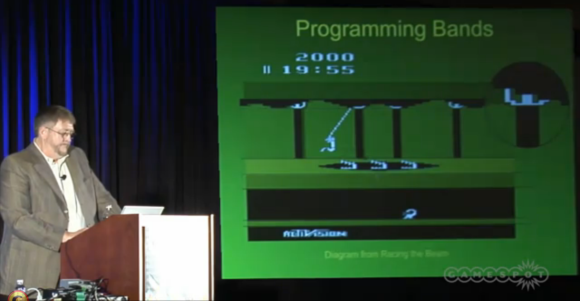
This week we’re taking another departure from the ordinarily campy videos featured in the Retrotechtacular section. This time around the video is only two years old, but the subject matter is from the early 1980’s. [David Crane], designer of Pitfall for the Atari 2600 gave a talk at the 2011 Game Developer’s Conference. His 38-minute presentation rounds up to a full hour with the Q&A afterwards. It’s a bit dry to start, but he hits his stride about half way through and it’s chock-full of juicy morsels about the way things used to be.
[David] wrote the game for Activision, a company that was started after game designers left Atari having been told they were no more important than assembly line workers that assembled the actual cartridges. We wonder if any heads rolled at Atari once Pitfall had spent 64-weeks as the number one worldwide selling game?
This was a developer’s panel so you can bet the video below digs deep into coding challenges. Frame buffer? No way! The 2600 could only pump out 160 pixels at once; a single TV scan line. The programs were hopelessly synced with the TV refresh rate, and were even limited on how many things could be drawn within a single scan line. For us the most interesting part is near the end when [David] describes how the set of game screens are nothing more than a pseudo-random number generator with a carefully chosen seed. But then again, the recollection of hand optimizating the code to fit a 6k game on a 4k ROM is equally compelling.
If you like this you should take a look at an effort to fix coding glitches in Atari games.
[via Reddit]















Some middle and high school kids asked me what video games did I play as a kid. This was the first one I named. .
my kids think i lived during the 1800s
Someday, they’ll have to live with, “You didn’t have your phone implanted in your head? How did you play games or watch movies without Glass?” :p
I’ve already had that with “Google didn’t exist then” and “game consoles couldn’t connect to the internet” and “phones didn’t have cameras” and that wasn’t THAT long ago. I’m too young to feel so old. ;_;
I had that as well with my cousins children. Except I was able to show them what gaming was like back then since I kept all my old hardware. I showed them a machine that was typical of Windows 95 era so that it was at least somewhat familiar to them, they still stumbled around like a blind man in a silent forest.
Once while in college, I carried my Compaq Contura 420C with me, and the little kids did not believe that that machine was made in the 90’s. They said that “computers didn’t exist then”.
It would be fantastic to create something like TED talks in which programmer and developers explain how did they create their games and/or programs.
Did you ever think of http://www.gamasutra.com been doing it for so long it isn’t funny
It’s been surely mentioned here before but if this sort of thing is your cup of tea, you need to check out the book “Racing the Beam: The Atari Video Computer System” by Bogost and Montfort.
Sounds quite a lot like how I write networking firmware for MCUs, 30 years later.
If you enjoyed this then you should read the book “Racing The Beam” it talks about the different programming challenges developers faced when creating games for the Atari. Apparently, the system was really only ever meant to do ball and missile games(so much that is actually had ball and missile registers). The Atari didn’t even have enough RAM to buffer an entire frame of gameplay.
I second that, Racing the Beam in awesome book. It’s a short read, but a great one.
Yes, Highly recommended.
If anyone is interested in learning Atari 2600 programming, there is an excellent pinned forum series by Andrew Davie over at AtariAge under “Sorted table of contents” here:
http://atariage.com/forums/viewforum.php?f=31
It’s how I learned 2600 coding a decade ago now (He was still posting chapters at the time) and it is an amazing little system for its time.
6507 CPU (a 6502 with some stuff missing), 128 bytes of RAM, 4k of directly addressable ROM space, and a TIA chip to send scan lines to the TV – which runs 3 times faster than the CPU does!
Super detailed info on Atari Age. Thx for the info!
There’s a Pitfall! clone for the TI-99/4A http://www.youtube.com/watch?v=Bazbju-p_Tg The TI was one of the few systems to not have Pitfall! ported to it in the 1980’s.
Eugene Jarvis has created two of my favorites, Defender & Robotron. He has some great tales to tell about optimization back in the day.
I NEED more talks like this !!!!!!!!!!!!!!!!!!
Any other videos giving the gist of older gaming systems?
Yes, I’m replying to myself.
Maniac Mansion and the Development of the SCUM Engine
https://www.youtube.com/watch?v=wNpjGvJwyL8